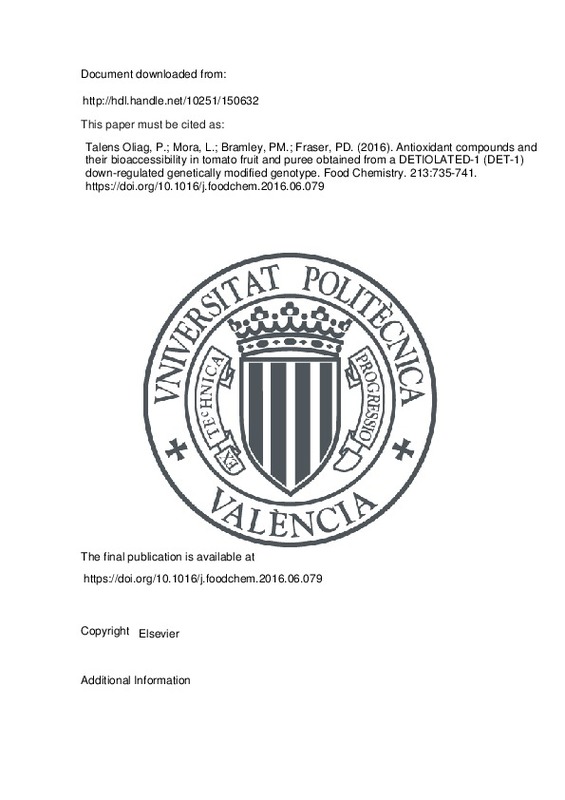JavaScript is disabled for your browser. Some features of this site may not work without it.
Buscar en RiuNet
Listar
Mi cuenta
Estadísticas
Ayuda RiuNet
Admin. UPV
Antioxidant compounds and their bioaccessibility in tomato fruit and puree obtained from a DETIOLATED-1 (DET-1) down-regulated genetically modified genotype
Mostrar el registro sencillo del ítem
Ficheros en el ítem
| dc.contributor.author | Talens Oliag, Pau
|
es_ES |
| dc.contributor.author | Mora, L.
|
es_ES |
| dc.contributor.author | Bramley, Peter M.
|
es_ES |
| dc.contributor.author | Fraser, Paul D.
|
es_ES |
| dc.date.accessioned | 2020-09-24T12:28:46Z | |
| dc.date.available | 2020-09-24T12:28:46Z | |
| dc.date.issued | 2016-12 | es_ES |
| dc.identifier.issn | 0308-8146 | es_ES |
| dc.identifier.uri | http://hdl.handle.net/10251/150632 | |
| dc.description.abstract | [EN] The economic value, the ease of cultivation and processing, and the well-known health-promoting properties of tomato fruit, make the tomato an important target for genetic manipulation to increase its nutritional content. A transgenic variety, down-regulated in the DETIOLATED-1 (DET-1) gene, has been studied in comparison with the parental line, for antioxidant levels in fresh and hot break fruit, as well as the bioaccessibility of antioxidants from puree. Differences in the concentrations of antioxidants between the wild-type and the genetically modified raw tomatoes were confirmed, but antioxidant levels were maintained to a greater extent in the GM puree than in the parent. The bioaccessibility of the compounds, tested using an in vitro digestion model, showed an increase in the genetically modified samples | es_ES |
| dc.description.sponsorship | L. Mora and P. D. Fraser are grateful to the EU-FP7 Marie Curie Intra-European Fellowship scheme (FOOSAF project) for financial resources. P. Talens acknowledges the Universidad Politecnica de Valencia for the financial support of a fellowship at the Centre for Systems and Synthetic Biology, School of Biological Sciences of Royal Holloway, University of London. Addition funds were received from FP6-EU-SOL and FP7 METAPRO projects (to PDF and PMB) | es_ES |
| dc.language | Inglés | es_ES |
| dc.publisher | Elsevier | es_ES |
| dc.relation.ispartof | Food Chemistry | es_ES |
| dc.rights | Reconocimiento - No comercial - Sin obra derivada (by-nc-nd) | es_ES |
| dc.subject | Tomato puree | es_ES |
| dc.subject | Bioaccessibility | es_ES |
| dc.subject | Thermal processing | es_ES |
| dc.subject | Genetically modified tomato | es_ES |
| dc.subject | Antioxidants | es_ES |
| dc.subject.classification | TECNOLOGIA DE ALIMENTOS | es_ES |
| dc.title | Antioxidant compounds and their bioaccessibility in tomato fruit and puree obtained from a DETIOLATED-1 (DET-1) down-regulated genetically modified genotype | es_ES |
| dc.type | Artículo | es_ES |
| dc.identifier.doi | 10.1016/j.foodchem.2016.06.079 | es_ES |
| dc.rights.accessRights | Abierto | es_ES |
| dc.contributor.affiliation | Universitat Politècnica de València. Instituto Universitario de Ingeniería de Alimentos para el Desarrollo - Institut Universitari d'Enginyeria d'Aliments per al Desenvolupament | es_ES |
| dc.contributor.affiliation | Universitat Politècnica de València. Departamento de Tecnología de Alimentos - Departament de Tecnologia d'Aliments | es_ES |
| dc.description.bibliographicCitation | Talens Oliag, P.; Mora, L.; Bramley, PM.; Fraser, PD. (2016). Antioxidant compounds and their bioaccessibility in tomato fruit and puree obtained from a DETIOLATED-1 (DET-1) down-regulated genetically modified genotype. Food Chemistry. 213:735-741. https://doi.org/10.1016/j.foodchem.2016.06.079 | es_ES |
| dc.description.accrualMethod | S | es_ES |
| dc.relation.publisherversion | https://doi.org/10.1016/j.foodchem.2016.06.079 | es_ES |
| dc.description.upvformatpinicio | 735 | es_ES |
| dc.description.upvformatpfin | 741 | es_ES |
| dc.type.version | info:eu-repo/semantics/publishedVersion | es_ES |
| dc.description.volume | 213 | es_ES |
| dc.identifier.pmid | 27451242 | es_ES |
| dc.relation.pasarela | S\319131 | es_ES |
| dc.contributor.funder | European Commission | es_ES |
| dc.contributor.funder | Universitat Politècnica de València | es_ES |







![[Cerrado]](/themes/UPV/images/candado.png)

